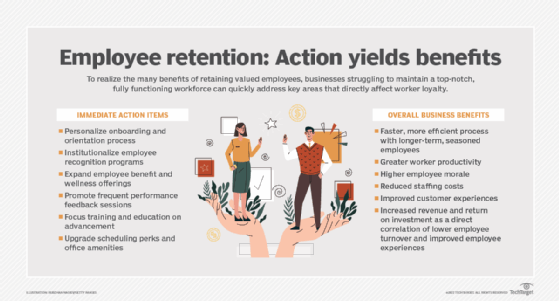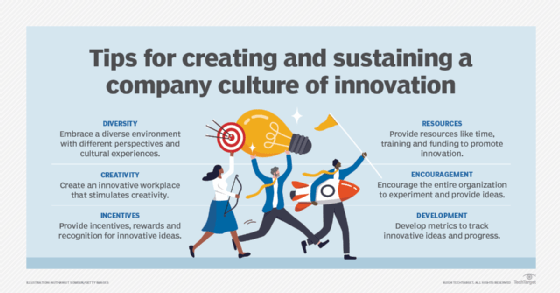
Rawpixel.com - stock.adobe.com
RTO mandates: Why they're happening and the possible outcomes
After years of remote work, some companies are making employees return to the office. Experts predict good and bad results with mentorship opportunities or employee turnover.
After several years of remote-heavy work, many organizations are asking their workforce to return to the office. Employee reactions have been mixed, and there is much speculation over how these changes will impact company culture, productivity, and revenue.
Amazon instituted its new 5-day in-office policy on Jan. 2, 2025, while the Washington Post expects all employees to follow a similar schedule by June of this year. Other companies implementing a return-to-office (RTO) strategy include JP Morgan Chase, Boeing, and Salesforce. Informa TechTarget announced a new 3-day "Time Together" policy for its global workforce, effective July 1, 2025.
While some companies embrace a fully office-based working mode, others pursue a hybrid approach. Other differences exist, such as how these policies are introduced and how management teams update the in-office experience to accommodate the change. What the mandates have in common is that they all seem to derive from a shared belief that in-person work provides value that remote working cannot.
Why return to the office?
Before the COVID-19 pandemic, remote working wasn't as widespread as today. Many organizations were forced to adopt work-from-home policies in March 2020 without the necessary planning and infrastructure, which initially disrupted productivity and created friction
Since those early months, however, teams have adapted to the new environment and found ways to work together while physically apart. In Omdia's latest "Future of Work" survey, over half of the respondents (52.2%) said that moving to more flexible work styles improved their productivity, while only 15.1% said their productivity had deteriorated. In terms of employee experience, 59.1% said flexible work had improved compared to 9.1% who reported deterioration.
Despite these gains, RTO mandates are increasingly common. Omdia analyst Adam Holtby attributes this shift partially to enduring perceptions around work.
"Despite the technological and practical advancements made over recent years, there is still a view amongst some that work productivity is tied to location," said Holtby. "Even for businesses that saw success with remote work at great scale (let's remember that this work style and supporting technologies likely kept many organizations in business during Covid), managers may still feel there is a different level of accountability and supervision in office environments that they feel isn't satisfied when people work away from the office."
It's not just about employee output and management oversight. Many HR professionals and managers have commented on the importance of fostering company culture and social connections between employees. With remote work, this is often seen as more of a challenge.
"Although remote work has proven productive, there's an underlying fear among leaders about losing connection, culture, and team cohesion for good," said Jackie Dube, chief people officer at The Predictive Index. "At the heart of it, businesses recognize that when employees don't feel a sense of inclusion and belonging, [their] retention, creativity, and performance suffer. Some organizations bring people back to the office because they believe proximity fosters these elements."
Organizations hope to reap various benefits by returning their workers to the office environment. Whether these will come to fruition is still unknown.

Potential outcomes
These RTO mandates will likely see varying degrees of success, depending on how they are implemented and how employees respond. During these early stages, industry experts have a few ideas of what the possible outcomes will be of returning to the office at scale:
Improved collaboration
One of the foremost reasons for returning workers to the office is the opportunity to gather in person and share ideas. Advocates for RTO mandates emphasize how in-office work allows for spur-of-the-moment collaboration. At the same time, remote workers might be limited to text-based communication, digital collaboration tools, or pre-scheduled virtual meetings. This in-person connection is particularly helpful for new employees or anyone working with unfamiliar colleagues.
"There are many instances where having that spontaneous brainstorming session or work session with a co-worker leaves a lasting impact on a new employee, making them feel the company culture firsthand," said Brenda Quach, director of HR and marketing at HR Transformed. "This is something that might be lacking in a fully remote workspace."
Particularly in creative industries or departments, where idea generation and development are critical, having people physically in the same place may allow for improved collaboration and productivity. "Offices aren't just spaces filled with desks; they're the starting points where spontaneous conversations spark ideas and visual and kinesthetic learners can genuinely engage with their work and teammates," said Monique Levy, founder and chief operating office of Levy Consulting Co.
However, analyst Holtby emphasized that "it is important that we remember that collaboration, regardless of location, needs purpose to be successful."
Initial employee turnover
Many HR professionals observed the differing perspectives on RTO between managers and their reports. While distance can make it harder for supervisors to monitor their supervisees' progress, non-management employees often favor the flexible nature of remote and hybrid working. After several years of working with this increased flexibility, it can be challenging to give that up. As a result, several of the experts surveyed predicted higher employee turnover rates due to new RTO policies.
"Employees are increasingly prioritizing work-life balance, autonomy, and the ability to work remotely, and ignoring this shift will send a message to the workforce that employee preferences and well-being are secondary to organizational priorities," suggested Tony Jamous, co-founder and CEO of human resource platform Oyster. "This misalignment can drive top performers to seek opportunities with organizations offering hybrid or fully remote options, leading to increased turnover."
Hayden Cohen, CEO of remote hiring platform Hire With Near, agreed that employee retention will be an issue: "Well-done RTO mandates are ones with strong buy-in from both employees and management. Companies with large numbers of remote or hybrid workers can't make this switch without going through a lot of turnover."
Greater mentorship for early-stage staff
One segment of the employee base might favor RTO mandates more than others: early-stage workers. Many people who entered the workforce during or after 2020 will have experienced a very different start to their careers than those before them due to the growth of remote work. While established employees may now prioritize greater flexibility, more junior staff can benefit from greater hands-on instruction and mentorship during these formative early years of employment.
"Many employers still support the idea of remote and hybrid teams but accept that it is often better for younger, inexperienced employees to spend time in the office along with mentors so that they can gain knowledge and learn the ropes more effectively," said Wendy Makinson, human resources manager at loading solutions provider Joloda Hydraroll.
Quach and Dube echoed these sentiments, expressing that it is easier for junior colleagues to connect with prospective mentors in both formal and informal capacities when both people are present in the same location. While there are systems for remote training and instruction, they believe that in-person connection can create more organic opportunities for learning.

Decreased talent acquisition
Tied to the potential upswing in employee churn is the potential struggle to attract top talent. Employees value flexible working at greater rates than before, and some hiring managers and recruitment services have observed that fully in-person positions receive less attention than remote or hybrid opportunities. Camille Fetter, CEO of Talentfoot Executive Search & Staffing, collected internal data on the potential affect of RTO on talent and hiring. Her results showed that, outside of the C-Suite, the response rate from candidates dropped by 70% for fully in-office jobs.
Alari Aho, CEO of recruitment software Toggl Hire, explained how he predicts RTO mandates will affect talent acquisition: "Companies that force employees to return to the office risk losing their top talent to remote-friendly competitors. … Those firms that continue to cling to outdated office models will be unable to hire and retain top talent, but those that embrace remote and hybrid flexibility will thrive."
Of course, this will likely vary depending on how many days a week a company enforces its in-office policy. Some prospective talent may only want fully remote roles, but others may be open to a blend of office- and home-based work. Omdia's Holtby believes some companies that operate a hybrid system can use this flexibility as a competitive advantage and a recruitment lever against those organizations that require fully in-office work.
Stronger company culture
Creating a sense of community at work has been challenging for decades, but many organizations felt this worsened during pandemic-induced remote working. Even as some workers returned to the office in a hybrid model, bridging the culture gap between remote and onsite employees was often difficult.
"I think many businesses have really struggled to build the digital-centric cultures needed in the modern work age," said Holtby. "Many organizations just brought legacy ways of working (and processes) into the digital age without a clear long-term strategy as to how they could take full advantage of these new ways of working."
Some experts believe that returning to in-office environments will ultimately lead to a stronger sense of company culture. Employees can better understand their company's values and mission by consistently gathering in a dedicated workspace. Simply spending more time together and building relationships with colleagues can also contribute to greater employee investment in the business goals.
This camaraderie and community can also be cultivated in person through team events and on-site activities, as opposed to strictly virtual ones. Many of the HR professionals consulted said it was important to make the office attractive to see positive material returns from RTO policies.
"Successful RTO strategies are marked by their ability to get people excited about returning to work," said Levy. "They effectively create a sense of FOMO [fear of missing out]. If concert venues and festivals have to entice people to show up, why are office spaces any different?"
Hybrid future
Of the many industry professionals consulted, a clear majority believe that fully in-person work is no longer the best path forward. Instead, they see successful RTO mandates as part of a general shift towards hybrid work styles that embrace the best of both in-office and remote working.
"Successful companies focus on intentional office time, not just a blanket RTO directive,” said Dube. "They design in-person interactions that actually add value, including collaboration and mentoring. They recognize that flexibility, like continuing to support hybrid work, isn't just a perk; it's a critical part of their talent strategy."
While there is some outright resistance to office-based work, many believe that there are benefits to in-person working—just not ones that need to come at the total expense of remote working benefits. Ultimately, there was a consensus that organizations that respond to employee feedback and meet their differing needs will thrive.
"In my view, the future of work will be hybrid," said Holtby. "It will be a blend of work styles, as it will be companies embracing this approach that will attract and retain the best staff. It isn't so much a conversation around pushing one work style over another, or one being better than another, but more a case of supporting and enabling employees across both based on preferences and role factors."
Madeleine Streets is a senior content manager for WhatIs. She has also been published in 'TIME,' 'WWD,' 'Self' and Observer.'








